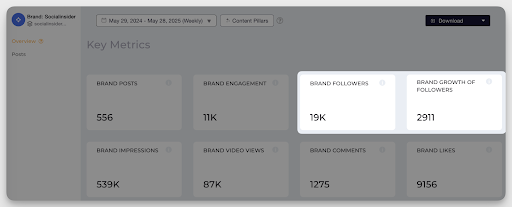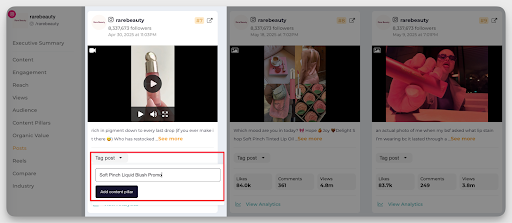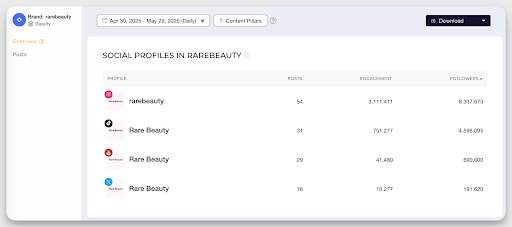Measuring Social Media ROI That Actually Matters to Executives

Measuring social media success often feels like chasing ghosts—plenty of likes, shares, and followers, but not much to show for it on the bottom line.
In fact, brands dedicated approximately 11% of their total marketing budgets to social media in 2024, yet many still ask: what is social media ROI?
At its core, it’s a measure of how much business value—revenue, leads, brand impact—you’re getting back for every dollar, hour, or post you put into social.
It involves backing decisions with data that actually moves the needle.
And it matters more than ever. With marketing budgets under scrutiny, being able to prove impact isn’t a nice-to-have—it’s a survival skill.
Luckily, this article cuts through the clutter and shows how aligning social media ROI with core business goals can turn data into decisions that marketing pros can’t ignore.
Understanding the Executive Mindset
To communicate social media’s true value to executives, first, you need to understand what drives their decisions.
Executives operate with a clear focus on how initiatives impact the company’s bottom line and long-term stability.
Unlike marketers who may focus on engagement or reach, executives are more likely to prioritize tangible business outcomes: boosting revenue, expanding market share, cutting costs, and managing risks.
However, social media teams often hit a wall when presenting results because traditional metrics—likes, shares, follower counts—rarely translate into these strategic outcomes.
This disconnect creates common pain points: executives see social metrics as superficial or irrelevant, making it hard for teams to justify budgets or demonstrate real business impact.
Thus, bridging this gap means we need to shift to a comprehensive framework that goes beyond vanity metrics, clearly connecting social media activity to strategic financial and operational goals.
Below, we’ll break down how to make that leap and turn social metrics into a language executives actually understand.
Essential ROI Metrics That Matter to Executives
Naturally, not all social media metrics carry equal weight.
Executives want to see numbers that directly impact the bottom line.
Thus, a great idea would be to focus on these key ROI metrics that speak their language and prove social media’s true value:
-
Customer lifetime value (LTV) from social channels
Measures the total revenue generated by customers acquired through social media over the entire duration of their relationship with the brand.
This demonstrates the lasting financial impact of social efforts.
Bonus points if the LTV of customers coming from social media is higher than the LTV of customers from other channels.
-
Brand awareness lift
Tracks increases in brand recognition and recall driven by social media activities, often measured through surveys, search volume growth, or social impressions, showing expanded market presence.
-
Share of voice
Represents the portion of conversations about your brand versus competitors on social platforms, reflecting your brand’s visibility and influence in the market.
This metric could be correlated with the total addressable market.
-
Customer retention rates (for social-acquired customers)
Measures how well customers gained via social media remain active and continue purchasing over time.
It indicates loyalty and the effectiveness of social engagement.
Again, bonus points if customers from social media have a better retention rate than customers from other channels.
-
Organic reach growth
Tracks the increase in the audience reached by unpaid social media content.
It highlights the effectiveness of your content strategy in generating authentic engagement.
To make tracking organic growth easier, Socialinsider provides historical data for 12 months or more, unlike native platforms that limit you to just 30 days.

As shown in the screenshot above, this long-term view helps you understand follower growth trends clearly.
Note: These metrics represent some of the important data points executives expect from social media teams. But they are just part of the bigger picture.
In addition to these, executives also focus on critical ROI metrics such as:
-
Revenue attribution
Revenue attribution identifies which social media activities directly drive sales.
It involves tracking lead generation and conversion rates to see how many potential customers come from social channels and actually buy.
-
Cost efficiencies
Social media spend often proves more cost-effective than traditional advertising, improving overall ROI.
By handling customer service issues quickly on social platforms, businesses reduce traditional support costs.
Additionally, operational efficiencies emerge by using social listening to guide decisions, helping prevent costly mistakes and streamline processes across departments.
-
Brand equity measures
Brand equity measures capture how social media shapes brand perception and trust.
On this note, tracking your share of voice reveals your visibility and influence in market conversations relative to competitors.
Moreover, sentiment analysis monitors whether mentions are positive or negative, offering insight into customer satisfaction and loyalty.
Social media also plays a critical role in crisis mitigation by enabling rapid detection and response to potential PR issues, protecting your brand’s reputation.
-
Competitive intelligence value
This leverages social media as a powerful tool to understand the broader market landscape.
It uncovers customer needs and preferences that can guide product development and innovation.
By spotting emerging trends early through social insights, brands gain a strategic edge to stay ahead in fast-moving markets and adapt quickly to changing consumer behavior.
How To Measure Social Media ROI (with Socialinsider)
Measuring these meaningful metrics consistently, especially if you want them in a single dashboard, can be challenging.
And this is where social media analytics platforms come into play.
Socialinsider, for example, offers a comprehensive platform that not only tracks key performance indicators aligned with your business goals but also turns complex data into actionable insights marketers can rely on.
By consolidating data across channels, enabling granular campaign tagging, and providing real-time reporting, Socialinsider helps marketers bridge the gap between social activity and tangible business outcomes.
With features tailored to measure everything from influencer impact to organic reach growth, it equips teams to optimize strategies continuously and prove social media’s true value in ways executives recognize and trust.
Here’s how it enables marketers to measure and improve ROI:
#1 Tracking key performance indicators (KPIs) aligned with goals
With Socialinsider, marketers can define clear objectives for their social campaigns and track the metrics that matter—engagement rates, conversions, reach, and impressions.
Using the Content Pillars feature, posts can be tagged by campaign or theme, making it easy to compare performance across different initiatives.


Moreover, for influencer collaborations, Socialinsider tracks specific metrics like video views, likes, comments, and shares to evaluate effectiveness.
#2 Centralized analytics & reporting
The platform aggregates data from multiple social channels into a unified dashboard.
This central view lets marketers monitor campaign performance across platforms effortlessly.
It’s also possible to add influencer or brand profiles to track posting activity and content results in real time.

#3 Data-driven optimization
By continuously analyzing campaign data, marketers can identify which content, channels, or influencers deliver the best results.
These insights enable real-time strategy tweaks to maximize ROI, whether reallocating budget to top performers or refining content based on engagement trends.
Implementation: Building Your Executive-Focused ROI Measurement System
You’ve heard it before: executives demand clear, actionable insights on how every dollar spent drives value.
To meet that expectation, your ROI measurement system must be precise, integrated, and strategically aligned across the organization.
Let’s walk through the critical steps to build a measurement framework that drives better decisions and stronger business impact.
#1 Set up proper attribution models
Why this matters: Proper attribution turns raw data into a compelling story that executives trust, showing how marketing, sales, and service efforts tangibly drive growth.
Attribution isn’t just about tracking where a lead or sale originated; it’s about understanding the true contribution of each touchpoint in the customer journey and internal processes.
- Move beyond last-click: Traditional last-click attribution oversimplifies complex buying behaviors. Incorporate multi-touch attribution models that weight interactions proportionally, recognizing influence across awareness, consideration, and conversion phases.
- Tailor models to your business reality: No one-size-fits-all. For B2B sales cycles or longer lead times, use time decay or position-based models that reflect your unique buyer’s path and touchpoints.
- Leverage advanced analytics: Use machine learning-powered attribution tools to uncover hidden correlations and dynamically adjust weights as market and customer behavior evolve.
- Validate continuously: Attribution models aren’t “set it and forget it.” Regularly audit for accuracy against actual outcomes, ensuring the system remains aligned with business realities and evolving strategies.
#2 Use tools and technologies for measuring business impact
Why this matters: The right tools are enablers, turning complex datasets into strategic assets, enabling leaders to make confident decisions swiftly.
Selecting and integrating the right technology stack is the backbone of any robust ROI measurement system.
It’s about choosing tools that not only collect data but also turn it into insightful, digestible intelligence.
- Unified Data Platforms: Invest in centralized platforms (like customer data platforms or integrated BI tools) that aggregate data from multiple sources — from CRM and marketing automation to finance and operations.
- Advanced Analytics & Visualization: Use tools with AI-driven analytics, predictive modeling, and customizable dashboards. Executive teams need clear, real-time visualizations that make ROI insights intuitive and actionable.
- Automated Reporting & Alerts: Free up time and reduce human error by automating report generation and setting triggers for KPI deviations or opportunities for optimization.
- Scalability & Flexibility: The chosen tech should scale with your company’s growth and adapt to new data sources, measurement requirements, or attribution models without costly overhauls.
#3 Cross-departmental collaboration requirements
Why this matters: Collaborative ownership ensures data integrity, accelerates insights, and drives culture change toward ROI-focused accountability.
ROI measurement isn’t the sole responsibility of marketing or finance—it’s a shared mission that requires strong collaboration across departments.
Thus, it’s important to:
- Establish clear ownership & roles: Define who is responsible for data collection, analysis, and reporting at each stage. Often, a cross-functional ROI task force can maintain alignment.
- Create shared goals & metrics: Align KPIs across teams, so everyone understands how their work contributes to overall ROI. For example, sales should be tied to marketing leads, and customer success tied to retention-driven revenue.
- Encourage transparent communication: Regular cross-department meetings or dashboards that everyone can access foster transparency and collective problem-solving.
- Invest in data literacy: Equip teams with training to interpret ROI data meaningfully, reducing miscommunication and encouraging data-driven actions.
#4 Data integration strategies
Why this matters: Without integration, ROI measurement risks fragmentation and errors. A unified, clean data environment is the foundation for accuracy and executive confidence.
Data is often fragmented across multiple systems: CRMs, ERP, marketing platforms, and finance software, which can create blind spots or conflicting reports if not integrated thoughtfully.
Some of the solutions include:
- Mapping your data landscape: Identify all relevant data sources and understand their structure, frequency of updates, and data quality.
- Using middleware & APIs: Employ integration platforms or middleware tools that seamlessly connect disparate systems, automating data flow without heavy manual intervention.
- Ensuring data standardization: Harmonize data formats, definitions, and timestamps to avoid inconsistencies. This includes agreeing on common identifiers like customer IDs or transaction codes.
- Prioritizing data governance: Implement protocols for data validation, privacy compliance, and security to maintain trust and reliability in the system.
- Planning for (near) real-time integration: Where possible, enable live data updates to provide executives with the freshest insights, not just lagging reports.
Future Trends: Where Social Media ROI Measurement Is Heading
The days of basic social metrics are fading.
As social media channels multiply and customer journeys grow more complex, traditional ROI measurement is hitting its limits.
And the future belongs to those who can harness smart technology and holistic data.
So let’s dive into the trends shaping the next generation of social media ROI measurement.
#1 AI and predictive analytics in social ROI
AI-powered predictive analytics is changing the game by transforming raw data into forward-looking intelligence.
Instead of waiting for a campaign to finish before evaluating its success, businesses can now anticipate outcomes, identify which audiences are most likely to engage, and detect shifts in consumer sentiment before they even happen.
This proactive approach is powered by AI’s ability to analyze huge volumes of unstructured social data—posts, comments, reactions—and uncover hidden patterns that humans can’t easily spot.
It continuously learns and updates attribution models, giving marketers real-time recommendations on where to focus their efforts and budgets.
Key benefits of AI-driven predictive analytics include:
- Dynamic attribution: constantly refining which touchpoints matter most.
- Sentiment forecasting: understanding not just what people say, but how they feel.
- Real-time optimization: shifting spend mid-campaign to maximize ROI.
- Audience insights: pinpointing high-value segments before they convert.
By integrating AI and predictive analytics, social ROI measurement becomes less about hindsight and more about seizing opportunities, turning social media from a cost center into a strategic growth engine.
Integration with broader marketing mix modeling
Social media doesn’t exist in a vacuum—it’s part of a vast, interconnected marketing ecosystem.
To truly grasp its ROI, social data needs to be woven into the broader tapestry of marketing mix modeling (MMM).
MMM traditionally helps businesses understand how different channels like TV, search, print, and digital advertising collectively drive sales and brand awareness.
Bringing social into this mix answers complex questions that single-channel analysis can’t: Does social media amplify your TV campaigns? Are social ads replacing paid search, or complementing it? How do offline promotions interact with online conversations?
The integration offers a unified, granular view of marketing effectiveness and helps executives allocate budgets with precision.
Effective integration involves:
- Data harmonization: standardizing social metrics alongside other channels.
- Cross-channel attribution: accounting for the interplay and synergy between channels.
- Scenario planning: testing how shifting social spend impacts overall marketing ROI.
- Advanced analytics platforms: using cloud-based solutions that handle fast-moving social data alongside traditional marketing metrics.
By embedding social media metrics within marketing mix models, businesses move beyond isolated ROI snapshots to a comprehensive understanding of their marketing impact. Thus, enabling smarter, data-driven decisions that maximize growth.
Measuring social media ROI: last thought
If you want social media to be seen as a driver, not a cost, now’s the time to level up your measurement game.
From choosing the right metrics and building cross-functional systems, to presenting insights in a way executives actually care about, the goal is simple: turn data into decisions.
Start by auditing your current metrics, aligning them with executive priorities, and building a reporting system that speaks the language of impact.
Because when you measure what matters—and communicate it well—ROI becomes more than a number. It becomes your strongest argument for doing more, and doing it better.

Source: Measuring Social Media ROI That Actually Matters to Executives




